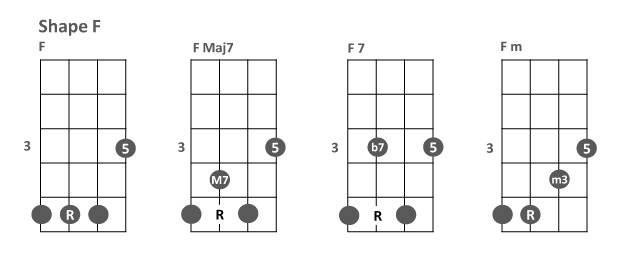A chord shape is a left-hand (for right-handed players) position your fingers make on the fret board which produces chords when strummed with the right-hand.
Introduction
The benefit of learning chord shapes is that it allows you to:
- Play smooth chord progressions with minimal shifting
- Transpose songs up and down the fretboard
- Play chord variations with minimal hand movement, i.e. C, Cm7, C7
- Play scales, melodies, and improvised solos related to the chord
- Develop your ear!
These are the most common shapes:

“R” indicates the root of the chord. The number on the note indicates the interval relative to the root of the chord.
These are all bar chords, which makes it easy to play in different keys up and down the fretboard.
Applying Chord Shapes to Chord Progessions
Using the chord shapes above, play a I-IV-V-IV chord progression in the Key of G.
G – C – D – G
Shape G is your I Chord, Shape C is your IV Chord, and Shape D is your V Chord. Start slow and repeat it until you get the sound of the chord progression in your ear. Sing the highest note you hear using solfege if you can. This will help you memorize the overall sound.
Now shift your left hand up two frets (a whole step), using the same chord shapes. This puts you in the Key of A:
A – D – E – D
Now let’s play the chord progression in the Key of C, but this time starting with Shape C as the I Chord, Shape F as the IV Chord, and Shape G, as the V Chord:
C – F – G – C
Transpose this chord progression to the key of D, by shifting up two frets:
D – G – A – D
Shape C is special, because the root of the chord is on the A string and it’s the highest sounding note. This makes it easy to know and hear what key you’re in.
For the bonus round, play the chord progression in the Key of F, using Shape F as the I Chord. The IV Chord will be Bb, and the IV Chord will be C.
F – Bb – C – F
Now you have to answer a question, but not a hard one. How do you play Bb? You play it the same way as you play C – by using Shape C, but shifting it down two frets to get you the Bb! Practice this progression until it comes naturally.
Do you see what’s going on? Your hand is starting to memorize the feel of a I-IV-V-IV chord progression from different starting chord shapes. Your ear is starting to memorize the sound of the same.
Practice Tips:
- Look away! Focus on the sound of what you’re playing and the feel of your left hand.
- Pick a random chord shape at a random spot on the fretboard. Play the chord progression and name the key you’re in.
- Sing the note on the A string using “ba”, then using solfege.
Moving Chord Shapes to Produce New Chords
It’s easy to form other chords from the basic chord shapes. With Shape G:
- Moving the root on the C string down a half step changes the G to a GMaj7
- Moving the notes on the G and A strings down a half step changes the G to a Gm (we have “flatted the 3rd’)
- Playing a Gm7 is a little more involved – we’ll let the diagram speak for itself!

With Shape C, the root is on two strings, the G string and the A string. A half-step movement of the root on the C string changes a C chord into a CMaj7 chord. Move the same note down another half step, gives you a C7. Moving the note on the C string down one half step changes the C7 to a Cm7:

Step-wise movements of a single note on Shape D, yields two new chords:

Step-wise movements of a single note on Shape F, yields three new chords:

Shape A does not include the A chord, but instead includes variations commonly used in jazz:

